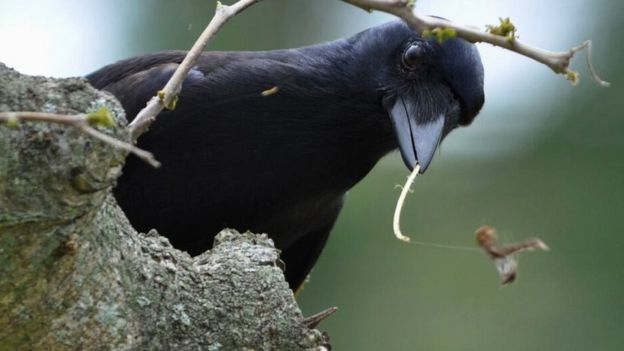
New Caledonian crows are smart, very very smart.
Last January the BBC highlighted a study that illustrated their tool making ability. They were shaping hooks out of plant material that they then used to fish for insets. These were not simply random twigs, but consisted of hooks that were far more efficient. These crows are the only animal we know that creates hooks. No wait, there is one other – us. About 23,000 years ago we also worked out how to create hooks.
Understanding what drove the crows’ tool-manufacturing provides Prof Rutz and his colleagues with a unique and valuable “non-human model” to investigate the origins of this fundamental step in human progress.
“When I see these crows making hooked tools, I have a glimpse of the very foundations of a technology that is evolving,” Prof Rutz said.
Juan Lapuente, an ecologist from Wurzburg University in Germany, who studies primate tool-use, said the tool-making and tool-using behaviour in crows was “amazing”.
Investigating Crow Intelligence
As part of an ongoing exploration of the evolution of intelligence researchers have been devising ways to test and measure what might be going on. One approach has been the construction of a special vending machine to test an idea.
Birds hear birdsong. They then absorb this song as a mental template and reproduce it. Could their tool making ability be transmitted in a similar manner?
crows’ tool designs could be culturally transmitted through a process of mental template matching. That is, individuals could use or observe conspecifics’ tools, form a mental template of a particular tool design, and then reproduce this in their own manufacture – a process analogous to birdsong learning.
There is a new study
Titled “Mental template matching is a potential cultural transmission mechanism for New Caledonian crow tool manufacturing traditions“, it explains how they trained the crows to drop paper of a specific size into a vending machine (wooden box) to get a reward delivered.
In fact, here is a BBC clip of one of the crows using the vending machine …
They did.
So what?
It supports the hypothesis that these crows are building a mental template for tools.
This mechanism can be considered analogous to avian song learning, in which juveniles first acquire a song template from listening to conspecifics, and then later adjust their own vocalisations until they match that of the memorised template. Significantly, the formation of a mental template would enable a bird to produce standardised tools without the requirement that existing tools are visible during manufacture. Most importantly, an improvement made by a crow during its lifetime could become part of the template learnt by subsequent generations, leading to an increase in tool complexity over time. Mental template matching is therefore a specific type of end-state emulation that could potentially allow for cumulative cultural change in the design of material artefacts.
Many questions still remain. For example, is there something very specifically unique about New Caledonian crows?
What is clear is that we are gaining some truly fascinating insights…
Our findings take the first step towards uncovering why New Caledonian crows show evidence of cumulative cultural evolution. While further work is clearly needed to test other predictions of the mental template matching hypothesis, our results do establish this mechanism as a leading contender for the wild tool designs of this species. A capacity for manufacture via emulation, through a mental template matching mechanism, could potentially reflect one of the minimal cognitive requirements for the emergence of cumulative material cultures.
One last thought.
If a crow has trouble getting his treat out of the crow vending machine, then what tool should it use?
(Oh come now, you can see this one coming)
A crowbar.
